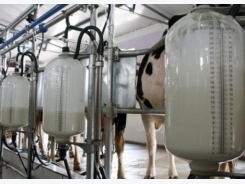Calf health starts with prevention

Keeping calves healthy in first part of life may reduce exposure to setbacks and health challenges later in life.
Ensuring that dairy calves get off to a great start in the first weeks of life helps set the stage for future growth and performance.
“Healthy calves in the first part of life may become less exposed to setbacks and health challenges later in life, which can result in optimal growth and lower management expenses,” said Dr. Julian "Skip" Olson, technical services manager for Milk Products.
Olson provided four keys steps to help calves thrive:
1. Support early health. Nutrition plays a significant role in early calf health. Supplements are available to help keep calves feeling and performing their best.
“Whether you feed your calves whole milk or milk replacer, consider an additive that optimizes early calf health,” Olson said. “Look for one that delivers a source of live, naturally occurring microorganisms. Beneficial bacteria have been shown to help maintain normal intestinal microflora and optimize digestion.”
Dried maternal colostrum can also help support calf intestinal health in the early stages of life. Some supplements will contain dried colostrum in addition to other beneficial ingredients.
“Including maternal colostrum beyond day one has been shown to help support digestive system health and immunity, resulting in optimal calf growth and overall health,” Olson said. “In addition to immunoglobulin G (IgG), colostrum supplementation provides many more substances that are of value to the calf immunoglobulins and immunity-enhancing molecules, as well as vitamins, minerals, growth factors and hormones.”
2. Keep feeding equipment clean. Sanitation and maintenance of feeding equipment are also important for calf health. If not regularly washed and sanitized, equipment can quickly become a harbor for bacteria.
Olson offered the following cleaning tips:
* Always use a separate bottle or pail for each calf.
* Wash pails, bottles and nipples in hot, soapy water, and rinse well after each feeding.
* Allow equipment to dry thoroughly between feedings. Moisture can create an ideal breeding ground for bacteria. If drying conditions are poor, consider drying the equipment with a clean towel.
* Sanitize with an approved disinfectant before use. For example, chlorine dioxide is an effective sanitizer at a low concentration.
3. Provide proper housing. Keep the following guidelines in mind. House calves in individual housing until weaning for the best chance of controlling disease spread from calf to calf; ensure adequate ventilation without direct drafts; provide and maintain a thick layer (6-10 in.) of clean, dry bedding of straw or shavings so the calf can easily nest into the bedding; prevent nose-to-nose contact, and disinfect hutches or stalls thoroughly between calves.
4. Stay ahead of health challenges. Part of raising calves is always looking ahead and trying to prevent stressful situations.
“As a calf raiser, part of your role is to pay close attention to temperatures shifts, extreme heat or cold, vaccination, transportation or weaning all factors that can cause calves to experience stressful situations (that result) in health challenges such as scours,” Olson said. “Feeding an electrolyte supplement ahead of these situations to avoid dehydration can help keep calves thriving.”
Electrolyte supplements can help support a calf’s immune system and keep them feeling their best. Be sure to offer electrolytes in addition to the calf’s normal diet, because electrolyte supplements do not contain all of the nutrients of whole milk or milk replacer.
“A calf’s first few months lay the foundation for their future,” Olson said. “By providing proper nutrition and supplements, adequate housing and clean feeding equipment, you can give calves a healthy, productive life.”
Có thể bạn quan tâm
Phần mềm

Phối trộn thức ăn chăn nuôi

Pha dung dịch thủy canh

Định mức cho tôm ăn

Phối trộn phân bón NPK

Xác định tỷ lệ tôm sống

Chuyển đổi đơn vị phân bón

Xác định công suất sục khí

Chuyển đổi đơn vị tôm

Tính diện tích nhà kính

Tính thể tích ao hồ




 Bovine genetics show startling diversity of Busa cattle
Bovine genetics show startling diversity of Busa cattle  Revised regional methane emission factors required for dairy…
Revised regional methane emission factors required for dairy…